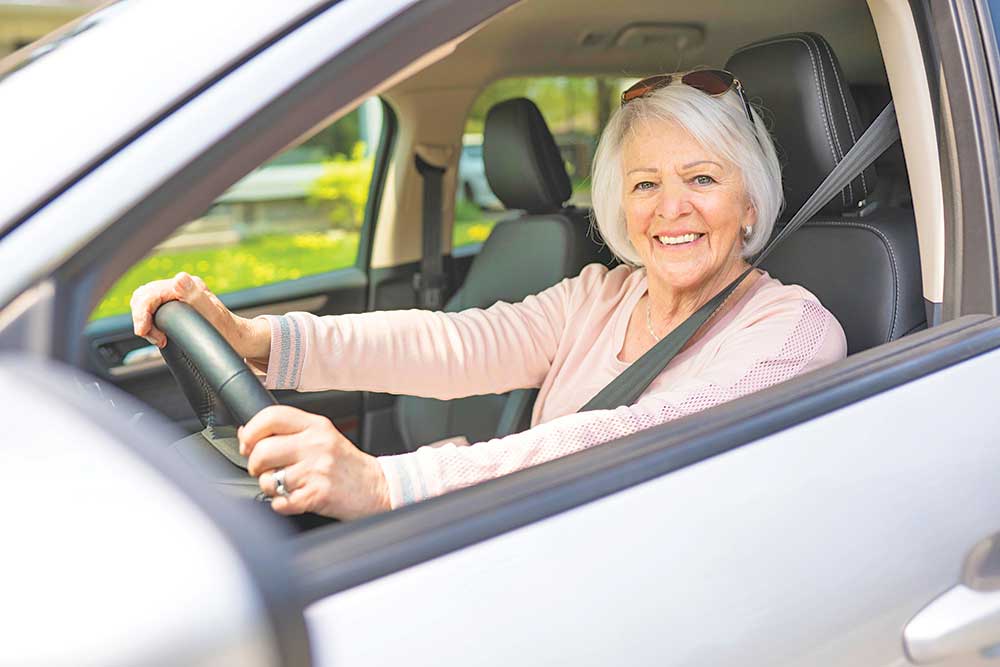
Staying Safe Behind the Wheel
Protecting Yourself, Staying Alert, and Feeling Fit
Older Drivers are Vulnerable
The Centers for Disease Control (CDC) tells us that older drivers, particularly those over 70, are more likely to be injured or killed in car crashes than middle-aged drivers, aged 35 to 54. This vulnerability makes it essential that older drivers protect themselves behind the wheel.
Wearing a seatbelt, driving during optimal times and conditions, minimizing distractions, and driving a safe, road-ready vehicle can help protect us, but there are other ways we can stay fit and safe while driving—and determine when it’s wisest to stop driving. Mayo Clinic geriatrician Dr. Erika Tung tells us that our doctor is a great resource to help us decide when to “retire” from driving—a critical decision best made with one’s physician.
Challenges Faced by Seniors Behind the Wheel
The National Institute on Aging (NIA) confirms what we know to be true: age-related changes can make driving more difficult. What are some of the changes we experience, and how can we be prepared?
Specifically, the NIA mentions these areas of potential concern:
- Stiffness in joints and muscles
- Reduced acuity in vision and hearing
- Medications that may induce drowsiness
- Slower reaction time/reflexes
- Medical conditions, such as Parkinson’s or stroke
Reading through the NIA list provides a good starting point when putting together questions for your next visit to your physician, who can identify relevant concerns and determine what kind of precautionary measures and exercises would be most helpful to you.
Staying Strong
We know how important exercise is to staying healthy and active, but have we considered the role exercise can play in safe driving? There are specific steps we can take to improve flexibility and range of motion, strength, and coordination, helping us feel more confident and comfortable behind the wheel.
Muscles lose strength and mass as we age in a process called sarcopenia. Although a natural part of aging, sarcopenia can be counteracted and even reversed with exercise. Retaining leg and arm strength is essential to safe driving. Here are just two of many possible exercises:
- Sit-to-Stands: Begin seated in a sturdy chair without arms. Press down into the floor with your feet, feeling the engagement of your thigh muscles, and rise to a standing position without using your arms. Carefully return to a seated position making sure the chair is securely underneath you.
- Bicep Curls: From a standing or seated position, anchor your upper right arm along the side of your body. Grip a water bottle or dumbbell with your right hand (palm facing up) and slowly raise the weight towards your shoulder. Lower to a point of extension that does not lock your elbow. Repeat on the left side.
Flexibility and Range of Motion
In an article entitled Driving Safely While Aging Gracefully, The National Highway Transportation Safety Administration (NHTSA) notes that staying flexible, particularly in the upper body and neck, can improve safety while driving. Flexibility means an increased range of motion, which refers to the extent of movement in a joint. For example, if we have limited range of motion in the facet joints of the cervical spine, or neck, we may find it uncomfortable and difficult to turn our head to check for oncoming traffic. Similarly, if our shoulders have limited range of motion, lifting our arms to bring our hands to grip the steering wheel might be uncomfortable.
These exercises can help improve flexibility and increase range of motion.
- Shoulder Stretch: Stand with feet about hip-width apart. Extend both arms straight out from the shoulders with palms facing down. Slowly raise both arms up towards the ceiling to a comfortable height. Slowly return arms to your sides.
- Chest Opener: Sit tall in a sturdy chair without arms with your back away from the back of the chair. Gently lift shoulders up and bring shoulder blades together to gently open the chest. Return to original position and repeat.
- Yes/No Exercise: Sitting tall in a sturdy chair, relax the shoulders down and away from the ears. Picture your chin parallel to the floor to help create length through the neck. Take a deep breath, and slowly turn your head to the right. On an exhaled breath, slowly return to center. Repeat on the left side. Keep shoulders relaxed, down, and still, slowly moving just head and neck.
Eye Exercises
Many yoga classes include exercises to engage the muscles around the eyes. According to Yoga Journal, asanas (exercises) for the eyes can help reduce the incidence of many age-related vision problems. These exercises are best done as part of relaxation, perhaps after exercising.
- Clock Face: Sit relaxed in a sturdy chair with your back against the back of the chair. Keeping your head still, look up as if you were looking at 12:00 on a large clock. Move your eyes slowly in a circular, clockwise direction around the face of the clock. After completing your circle, close your eyes to give them a rest. Repeat moving in a counterclockwise direction.
- Focal Range: Sit relaxed in a sturdy chair with your back against the back of the chair. Release shoulders down and away from the ears. Extend the right arm straight out from the shoulder with fingers curled into the palm and thumb extended up towards the ceiling. Focusing on the thumbnail, slowly draw the arm towards the body, letting the thumb come towards the nose. Notice the change in focus as your thumb nears your body. Repeat on the left side.
Grip Strength
Hand strength is one of the keys to maintaining independence in activities of daily living. According to SilverSneakers, a health and fitness program dedicated to older adults, grip strength is an important measure of overall body strength and muscle tone. Geriatric specialist Dr. Ardeshir Hashmi of the Cleveland Clinic adds that grip strength starts to decline around age 50, and recommends squeezing a racquetball or squash ball for ten minutes twice per day to maintain grip strength.
Grip strength is also a component of safe driving, whether we’re holding the steering wheel or the gear shift knob. These exercises, in addition to the exercise recommended by Dr. Hashmi, can help strengthen the muscles that keep our grip strong.
- Clench and Extend: Anchoring the upper right arm against the body, slowly draw the fingers together to make a fist. Slowly extend the fingers, creating a “starfish” by reaching fingers out. Repeat on the left side.
- Wrist Curls: Holding a very light dumbbell or water bottle, lean forward in your sturdy chair to rest your right forearm on your right thigh. Moving just your wrist, slowly raise and lower your weight to engage the wrist and muscles of the forearm. Repeat on the opposite side. Be sure to use very light weight—or no weight—and move slowly within an appropriate range of motion.
The Importance of Coordination
A scholarly article published in the National Library of Medicine defines driving as “an everyday task involving a complex interaction between visual and cognitive processes.” Eye-head coordination and dynamic visual scanning are the specific skills mentioned as being essential to safe driving. Coordination, one of these essential components, can be thought of in three general categories:
- Gross Motor (large muscles of the arms and legs) walking, dancing, throwing, running
- Fine Motor (small muscles of hands and wrists and feet and toes) writing, using a computer, sewing, typing, eating, playing an instrument
- Hand/Eye (connection between visual information and brain) driving, cooking, racquet sports, juggling, painting, yoga, tai chi
Harvard Health tells us that any of these coordination-enhancing activities can be modified to fit our own fitness levels, needs, and abilities.
Additional Resources
More on senior fitness, including online classes and videos.
Coordination exercises for active aging adults from the American Council on Exercise.
Additional information on eye exercises.
Strength training for seniors.
The American Occupational Training Association has Driving Rehabilitation Specialists.
AAA offers a skills-based RoadWise Driver course specifically for older adults.
The Importance of a Supportive Community
Most seniors want to enjoy the independence of driving for as long as possible. Dr. Erika Tung, the geriatrician from the Mayo Clinic, reminds us that seniors will spend six to 10 years not driving. A community that provides myriad activities, opportunities for engagement, excursions, and transportation is essential, particularly during these non-driving years.
Come explore Plymouth Harbor and learn more about this extraordinary community where all of these benefits and more are provided to residents. Call 941-365-2600 to schedule your private tour and discover why life truly is better on Sarasota Bay!



